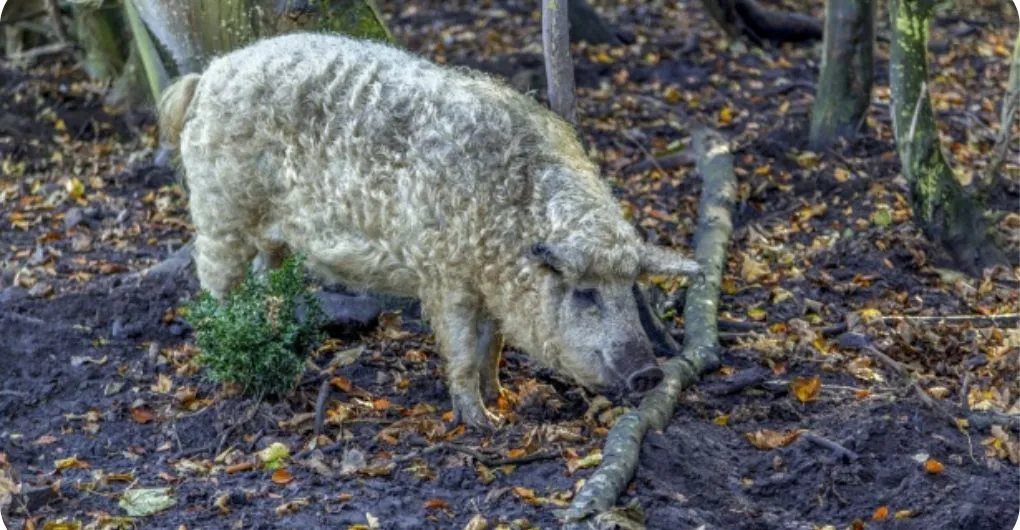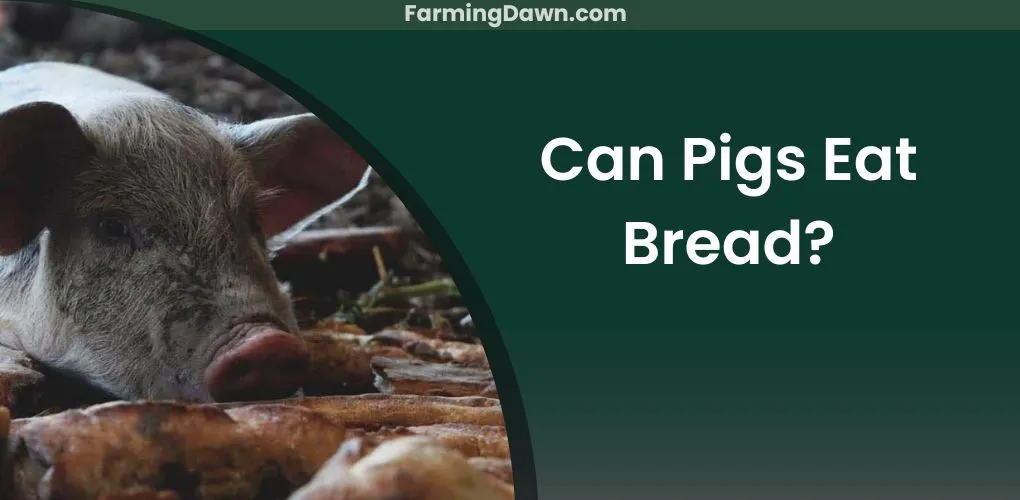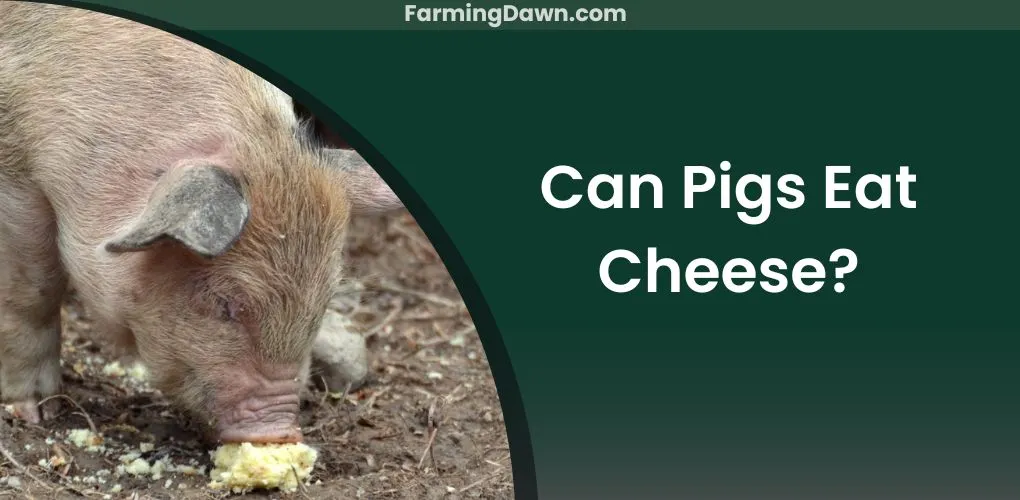It’s been said that mangalitsa pigs are the Kobe beef of pork. They’re known for their marbling and flavor, making them a favorite among chefs and home cooks. But what to feed Mangalitsa pigs to ensure they stay healthy? In this article, I will share my secrets on feeding your mangalitsa pig so it can live its best life!
What To Feed Mangalitsa Pigs?
Natural Diet
Mangalitsa pigs, the woolly wonders of the piggy world, need a diet that allows them to thrive. It’s not just about what they eat; it’s also about how and when they are fed.
In nature, these creatures would be foraging in the wild, feasting on grasses, roots, fruits, and insects. In our modern-day environment, where their habitat is limited to a pen or yard, we must provide substitutes to mimic this natural diet as much as possible.
- Greens like kale and dandelion leaf will give them essential vitamins while providing fiber and minerals.
- Grains like oats can offer balanced nutrition with protein and carbohydrates to fuel growth and development.
- Legumes such as peas are excellent sources of fiber too.
However, fruit should be offered sparingly; the high sugar content can cause digestive issues if over-consumed. Various vegetables, from carrots to squash, can round out their eating experience – an opportunity for enrichment through food exploration!
Nutritional Requirements
When it comes to feeding Mangalitsa pigs, I’ve learned that they need nutrition to support their highly active lifestyle. These little pigs like nudging and wallowing in the mud! It’s essential to provide a diet that meets their needs while allowing them to indulge in their natural behaviors.
I recommend providing your Mangalitsas with grass-fed hay, pasture, and grains such as:
- Barley
- Wheat
- Oats
- Corn
They also benefit from small amounts of good-quality proteins like eggs, fish meals, and cooked legumes. There should always be fresh water available for them too. And don’t forget about minerals; these porkers can pack away some nutrients if given the opportunity!
Now let’s talk about what feeds you should avoid giving your pigs…
Recommended Feeds
Now that we’ve covered the nutritional requirements for Mangalitsa pigs let’s talk about what to feed them. I firmly believe in feeding various items without relying on one or two primary sources. With this mindset, plenty of options are available when it comes to feeding your Mangalitsas.
First, you’ll want to provide fresh hay as their primary source of nutrition. This should be supplemented with small grains such as barley, oats, wheat, and corn for additional protein and fat. You can also offer fruits and vegetables like apples, carrots, squash, sweet potatoes, etc., to help balance their diet.
Grains can be fed in pellet or mash form, depending on preference. Pellets make feeding easier because they’re uniform in size and shape; however, mashes may better suit some animals due to their more familiar texture. If you opt for pellets or mash forms, always ensure that they meet the nutritional needs of your pig by reading through the label carefully before purchase.
Pellet Or Mash?
The two main options, pellets or mash, each have its benefits and drawbacks, so knowing which works best for your animals is essential.
- Pellets
Pallet pellets are easier to store, and transport than mash and usually have more nutrients per pound than a mash would. Also, because they come in pellet form, they can’t be spilled as quickly as a mash could. However, there is something that you need to watch out for.
Some pellets contain fillers such as grains or by-products that aren’t suitable for Mangalitsas, who need high-fat levels in their diet. So if you decide to go with pellets, make sure to find ones designed specifically for Mangalistsas – this way, you know you’ll get the proper amount of nutrition without any unhealthy additives.
- Mash
Mash, on the other hand, is a mixture of different ingredients like vegetables, fruits, nuts, and grains, all ground into a paste and then mixed before being fed to the hogs. It offers plenty of customizability regarding what type of food your hogs will be eating – allowing you to select whatever mix suits their needs at any time. Plus, since these ingredients are already prepped ahead of time, feeding becomes much faster and less labor-intensive compared to grinding up individual items yourself every day.
Mashes don’t typically include unnecessary fillers like cheaper brands of pellets do (though always double-check, just in case). However, mashes spoil faster than pellets, so if not eaten within 24 hours, they should be discarded rather than stored away.
If you want to raise a cute and low maintenance pig breed, consider raising Sheltie Guine pig
Protein Sources
Now that we’ve discussed pellets and mash as feed options for Mangalitsa pigs let’s talk about protein sources. A balance of well-sourced proteins is critical to maintaining the health of your herd. What to feed mangalitsa pigs to cover their protein needs? To cover their protein requirements, it’s essential to understand how you can meet those needs in economically sensible ways.
For example, suppose you have access to plentiful pasture grasses or clover. In that case, these are great choices since they provide natural fiber and essential nutrients like calcium. If not, hay may be an option – though it should be high quality with minimal dust content.
Grains such as oats, wheat, and barley also make suitable feed items; however, corn is too starchy for this breed, so avoid feeding it regularly. Protein-rich meal worms or maggots will also attract a lot of attention from the herd!
Protein sources from animal origin include poultry manure (relatively low-fat content), fishmeal, and marine shrimp meals, which offer good levels of omega-3 fatty acids but tend to be more expensive than other options.
Offal products such as beef heart, kidney, or liver make excellent treats when fed sparingly. With all these options available, consider carefully what works best for you and your herd – financially and nutritionally! Now let’s move on to discuss fats & oils…
Fats & Oils
Fats and oils are a vital part of the Mangalitsa pig’s diet. These fats are what make their meat so sought after! All animals, including pigs, should have access to good-quality fat in their diets. As I see it, healthy fats provide essential fatty acids for growth and development, help with digestion and keep joints lubricated.
One of my favorite dietary additions for Mangalitsas is lard. It’s a great energy source but also provides plenty of monounsaturated fats and vitamin E to help boost overall health. You can find high-quality lard from pasture-raised pigs at your local butcher or farmer’s market – make sure you check labels carefully! Other healthy fat sources include coconut oil, olive oil, and butter – again, ensuring they’re sourced sustainably.
Vitamins & Minerals
Now that we’ve discussed fats and oils let’s move on to vitamins and minerals. Just like humans, Mangalitsa pigs need the right balance of vitamins and minerals to stay healthy. Fortunately, they don’t require a lot of supplementation if you provide them with all the necessary elements for their diet.
Good quality hay should contain most of the essential nutrients your pigs need. However, some additional supplements can help fortify their diets even more. You’ll want to find a mineral blend formulated explicitly for swine that contains calcium, phosphorus, magnesium, sodium chloride (salt), potassium iodide (iodine), iron, zinc, cobalt, and copper, as well as trace minerals such as selenium and manganese.
Suppose you feed your pigs pasture grasses or grains such as oats or barley. In that case, you should also supplement these with additional vitamins A and D3. Feeding raw eggshells is another way to add extra calcium too!
Supplements
Piggy pleasures and plentiful provisions are paramount for a Mangalitsa pig. Supplements can be the perfect pick-me-up to provide proper sustenance for these prized porkers. Supplementing their diet with additional minerals, vitamins, and enzymes is essential for ensuring the optimal health of your swine companion.
To start, consider adding some probiotics, which will help improve digestion by introducing beneficial bacteria into the digestive tract. Probiotics also aid in boosting immunity which helps keep diseases at bay, all while providing an additional source of nutrients that may not already be found in their feed.
Also, including trace minerals such as zinc or copper, can ensure nutrition needs are met since these ingredients often need to be included in commercial feeds. Lastly, it’s important to note that many supplements on the market contain added fillers like grains or sugars, so make sure you read labels carefully when selecting one!
Foraging For Food
Mangalitsa pigs are foragers by nature. They love to root around the ground and dig up yummy treats! Allowing them access to grassy areas is a great way to provide variety in their diet, as they can pick through all kinds of tasty plants and shrubs. You may even be surprised at some of the things they find – I once saw one digging up an old shoe!
This kind of natural foraging is not only fun for the pig, but it also helps keep him healthy and fit. He’ll receive a wide range of nutrients that he wouldn’t get from store-bought feed alone. It’s essential to ensure enough open space for your Mangalitsa Pig to roam free, so he can enjoy his natural surroundings while getting plenty of exercises. This will help ensure he lives a long and happy life with you!
What To Feed Mangalitsa Pigs? Final Thoughts
So, what to feed mangalitsa pigs to ensure they stay healthy and active? The key is ensuring they get enough protein and fat while providing vitamins and minerals to stay healthy and happy. After all, an ounce of prevention is worth a pound of cure! It’s important to remember that when feeding your Mangalitsa pigs, you want to provide them with a balanced diet rich in natural foods. If you have any other questions ask me in the comments. Thank you!







